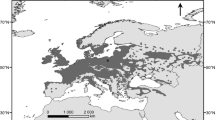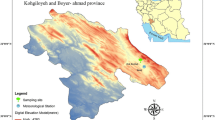Abstract
Key message
Anatomical characteristics and hydrologic signals in tree-rings of oaks from areas with regular flooding may vary, even within the same forest stand, and largely depend on the micro-environmental conditions.
Abstract
Q. robur decline in European floodplain forests in recent years seems to be strongly associated with the deteriorating hydrological regime. We investigated the influence of the Krka River flow on tree-ring patterns of Q. robur from the Krakovo floodplain forests (Slovenia) to assess the effect of micro-location conditions on hydrological signals in wood-anatomical characteristics. We selected two groups of Q. robur trees growing at nearby locations with different hydrological conditions, resulting in frequent autumn and spring flooding at the wetter site (=W oaks) but no flooding at the other, drier site (=D oaks). We found differences between the two groups in the anatomical structure of tree-rings; however, ring width proved to be the main variable determining the anatomical structure of oak wood. D and W oaks responded differently to the Krka River flow in the studied period. Radial growth of D oaks was negatively influenced by spring flow, but positively influenced by minimum summer flow. In W oaks, ring width was positively correlated with mean summer flow. Thus, environmental information stored in wood-anatomical features may vary, even within the same forest stand, and largely depends on the micro-environment. Reduced wood increments of D oaks suggest that growth conditions are less favourable, implying a link between the health state of oaks from lowland forest and hydrological conditions. Trees intended for hydrological reconstruction must therefore be carefully selected to avoid the possibility of error and potential loss of information. Anatomical characteristics and hydrological signals in tree-rings of oaks from areas with regular flooding may vary, even within the same forest stand, and largely depends on the micro-environmental conditions.







Similar content being viewed by others
References
Bigler C, Gričar J, Čufar K (2004) Growth patterns as indicators of impending tree death in silver fir. Forest Ecol Manag 199:183–190
Biondi F, Waikul K (2004) DENDROCLIM2002:a C ++ program for statistical calibration of climate signals in tree-ring chronologies. Comput Geosci 30:303–311
Bréda N, Granier A (1996) Intra- and interannual variations of transpiration, leaf area index and radial growth of a sessile oak stand (Quercus petraea). Ann Sci Forest 53:521–536
Carlquist S (1988) Comparative Wood Anatomy. Springer Verlag, Berlin/Heidelberg
Čater M (2003) Pendulate oak (Quercus robur L.) crown defoliation-changes on permanent research plots. Ekológia 22:430–443
Čater M, Batič F (2006) Groundwater and light conditions as factors in the survival of pedunculate oak (Quercus robur L.). Eur J Forest Res 125:419–426. doi:10.1007/s10342-006-0134-6
Čater M, Levanič T (2004) Increments and environmental conditions in two slovenian pedunculate-oak forest complexes. Ekológia 23:353–365
Čater M, Kutnar L, Accetto M (2001) Slovenian lowland and floodplain forests In: Klimo E, Hager H (eds) The floodplain forests in Europe: current situation and perspectives. Brill, Leiden Boston Köln. p 233–248
Charton FL, Harmon JR (1973) Dendrochronology in northwestern Indiana. Ann Assoc Am Geogr 63:302–311. doi:10.1111/j.1467-8306.1973.tb00927.x
Cook ER, Holmes RL (1986) Users manual for program ARSTAN. In: Holmes RL, Adams RH, Fritts HC (eds) Tree-ring chronologies of Western North America: California. Eastern Oregon and Northern Great Basin. Laboratory of Tree-Ring Research, University of Arizona, p 50–65
Čufar K, Levanič T (1999a) Progress of dendrochronological research in Slovenia. Dendrochronologia 16–17:173–181
Čufar K, Levanič T (1999b) Tree-ring investigations in oak and ash from different sites in Slovenia. Phyton 39:113–116
Čufar K, De Luis M, Eckstein D, Kajfež-Bojataj L (2008) Reconstructing dry and wet summers in SE Slovenia from oak tree-ring series. Int J Biometeorol 52:607–615
Eilmann B, Weber P, Rigling A, Eckstein D (2006) Growth reactions of Pinus sylvestris L. and Quercus pubescens Willd. to drought years at a xeric site in Valais, Switzerland. Dendrochronologia 23:121–132
Eilmann B, Zweifel R, Buchmann N, Fonti P, Rigling A (2009) Drought-induced adaptation of the xylem in Scots pine and pubescent oak. Tree Physiol 29:1011–1020
Estes EE (1970) Dendrochronology of black oak (Quercus velutina Lam.), white oak (Quercus alba L.), and shortleaf pine (Pinus echinata Mill.) in the Central Mississippi Valley. Ecol Monogr 40:295–317
Ferner E (2009) Effects of flooding on the carbon metabolism of beech (Fagus sylvatica, L.) and oak (Quercus robur, L.). Dissertation, Albert-Ludwigs-Universität Freiburg im Breisgau
Fonti P, García-González I (2004) Suitability of chestnut earlywood vessel chronologies for ecological studies. New Phytol 163:77–86
Fonti P, Treydte K, Osenstetter S, Frank D, Esper J (2009) Frequency-dependent signals in multi-centennial oak vessel data. Palaeogeogr Palaeoclimatol Palaeoecol 275:92–99
Fonti P, von Arx G, García-González I, Eilmann B, Sass-Klaassen U, Gärtner H, Eckstein D (2010) Studying global change through investigation of the plastic responses of xylem anatomy in tree rings. New Phytol 185:42–53
Friedrichs DA, Neuwirth B, Winiger M, Löffler J (2009) Methodologically induced differences in oak site classifications in a homogeneous tree-ring network. Dendrochronologia 27:21–30
Gasson P (1987) Some implications of anatomical variations in the wood of pedunculate oak (Quercus robur L.). including comparisons with common beech (Fagus sylvatica L.). IAWA Bull 8:149–166
George SS, Neilsen E, Conciatori F, Tardif J (2002) Trends in Quercus macrocarpa vessel areas and their implications for tree-ring paleoflood studies. Tree-Ring Res 58:3–10
Gozdnogospodarski načrt gozdnogospodarske enote Krakovo 2006–2015 (Forest management plan for Forest Management Unit Krakovo 2006–2015) (2006) Zavod za gozdove Slovenije, območna enota Brežice. Brežice
Guilley É, Hervé J-C, Huber F, Nepveu G (1999) Modelling variability of within-ring density components in Quercus petraea Liebl. with mixed-effect models and simulating the influence of contrasting silvicultures on wood density. Ann For Sci 56:449–458
Hager H, Buchleitner E (2001) The floodplain forests along the March and Thaya rivers in Austria. In: Klimo E, Hager H (eds) The floodplain forests in Europe: current situation and perspectives. Brill, Leiden Boston Köln, pp 51–66
Haraszthy L (2001) The floodplain forest in Hungary. In: Klimo E, Hager H (eds) The floodplain forests in Europe: current situation and perspectives. Brill, Leiden Boston Köln, pp 17–24
Hinckley TM, Dougherty PM, Lassoie JP, Roberts JE, Teskey RO (1979) A severe drought: impact on tree growth, phenology, net photosynthetic rate and water relations. Am Mid Nat 102:307–316
Kadunc A (2010) Kakovost, vrednostne značilnosti in produkcijska sposobnost sestojev doba in gradna v Sloveniji = Quality, value characteristics and productivity of Pedunculate and Sessile oak stands in Slovenia. Gozd Vestn 68:217–226
Kaiser HF (1992) On the invariance of the sum of coefficients alpha for factors under orthogonal rotation. Psychol Rep 70:545–546. doi:10.2466/pr0.1992.70.2.545
Klimo E, Hager H (2001) Executive summary. In: Klimo E, Hager H (eds) The floodplain forests in Europe: current situation and perspectives. Brill, Leiden/Boston/Köln, p vii
Leal S, Sousa VB, Pereira H (2007) Radial variation of vessel size and distribution in cork oak wood (Quercus suber L.). Wood Sci Technol 41:339–350. doi:10.1007/s00226-006-0112-7
Leal S, Nunes E, Pereira H (2008) Cork oak (Quercus suber L.) wood growth and vessel characteristics variations in relation to climate and cork harvesting. Eur J Forest Res 127:33–41. doi:10.1007/s10342-007-0180-8
Lebourgeois F, Cousseau G, Ducos Y (2004) Climate-tree-growth relationships of Quercus petraea Mill. stand in the Forest of Bercé (“Futaie des Clos”, Sarthe, France). Ann For Sci 61:361–372. doi:10.1051/forest:2004029
Lei H, Milota MR, Gartner BL (1996) Between- and within-tree variation in the anatomy and specific gravity of wood in Oregon white oak (Quercus garryana Dougl.). IAWA J 17:17
Leuschner HH, Sass-Klaassen U, Jansma E, Baillie MGL, Spurk M (2002) Subfossil European bog oaks: population dynamics and long-term growth depressions as indicators of changes in the Holocene hydro-regime and climate. Holocene 12:695–706. doi:10.1191/0959683602hl584rp
Levanič T (1993) Vpliv melioracij na debelinsko rast in prirastek črne jelše, ozkolistnega jesena in doba v Prekmurju (Effects of hydromelioration on diameter growth and increment of black alder, ash and oak in Slovene Prekmurje). Zb Gozdar Lesar 42:7–65
Levanič T, Čater M, McDowell NG (2011) Associations between growth, wood anatomy, carbon isotope discrimination and mortality in a Quercus robur forest. Tree Physiol 31:298–308
Nardini A, Tyree MT (1999) Root and shoot hydraulic conductance of seven Quercus species. Ann For Sci 56:371–377
Phelps JE, Workman EC (1994) Vessel area studies in white oak (Quercus alba L.). Wood Fiber Sci 23:315–321
Pilcher JR (1996) Dendrochronological insights into past oak growth. Ann For Sci 53:663–671
Prpić B (2003) Utjecaj tehničkih zahvata u prostoru na nizinske šume (The effect of technical operations in the area of lowland forests). Šumarski list 5–6:230–235
Quinn GP, Keough MJ (2002) Experimental design and data analysis for biologists. Cambridge University Press, New York
Rao RV, Aebischer DP, Denne MP (1997) Latewood density in relation to wood fibre diameter, wall thickness, and fibre and vessel percentages in Quercus robur L. IAWA J 18:127–138
Sass-Klaassen U, Hanraets E (2006) Woodlands of the past—The excavation of wetland woods at Zwolle-Stadshagen (the Netherlands): Growth pattern and population dynamics of oak and ash. Geol Mijnbouw-N J G 86:61–71
Sass-Klaassen U, Sabajo CR, den Ouden J (2011) Vessel formation in relation to leaf phenology in pedunculate oak and European ash. Dendrochronologia 29:171–175. doi:10.1016/j.dendro.2011.01.002
Sass-Klassen U, Sabajo C, Belien E, den Ouden J (2010) Effect of experimental flooding on vessel area of pedunculate oak and common ash—a matter of timing. In: Mielikäinen K, Mäkinen H, Timonen M (eds) WorldDendro 2010: the 8th international conference on dendrochronology. Rovaniemi, Finland, p 155
Schmull M, Thomas MF (2000) Morphological and physiological reactions of young deciduous trees (Quercus robur L., Q. petraea [Matt.] Liebl., Fagus sylvatica L.) to waterlogging. Plant Soil 225:227–242. doi:10.1023/A:1026516027096
Tardif JC, Conciatori F (2006) Influence of climate on tree rings and vessel features in red oak and white oak growing near their northern distribution limit, southwestern Quebec, Canada. Can J Forest Res 36:2317–2330. doi:10.1139/x06-133
Tyree MT, Zimmermann MH (2010) Xylem structure and the ascent of sap. Springer-Verlag, Berlin/Heidelberg/New York
Vukelić J, Rauš Đ (2001) The lowland forest of Croatia: 101–127. In: Klimo E, Hager H (eds) The floodplain forests in Europe: current situation and perspectives. Brill, Leiden/Boston/Köln, pp 101–126
Wimmer R (2002) Wood anatomical features in tree-rings as indicators of enviromental change. Dendrochronologia 20:21–36
Zhang SY (1997) Variations and correlations of various ring width and ring density features in European oak: implications in dendroclimatology. Wood Sci Technol 31:63–72
Zhang SY, Zhong Y (1991) Effect of growth rate on specific gravity of East-Liaoning oak (Quercus liaotungensis) wood. Can J Forest Res 21:255–260. doi:10.1139/x91-031
Žibert F (2006) Sestojna zgradba v pragozdnem rezervatu Krakovo in gospodarskem gozdu (Stand structure in virgin forest reserve Krakovo and managed forest). Thesis, University of Ljubljana
Acknowledgments
The authors gratefully acknowledge the help of Špela Jagodic and Robert Krajnc from the Slovenian Forestry Institute in the field and laboratory. In addition, they would also like to thank the anonymous reviewers for their valuable comments and suggestions to improve the quality of the paper. The Slovenian Research Agency supported this work in part through the young researchers’ program (Polona Hafner), by P4-0107 and by project L4-9653.
Author information
Authors and Affiliations
Corresponding author
Additional information
Communicated by A. Braeuning.
Rights and permissions
About this article
Cite this article
Gričar, J., de Luis, M., Hafner, P. et al. Anatomical characteristics and hydrologic signals in tree-rings of oaks (Quercus robur L.). Trees 27, 1669–1680 (2013). https://doi.org/10.1007/s00468-013-0914-9
Received:
Revised:
Accepted:
Published:
Issue Date:
DOI: https://doi.org/10.1007/s00468-013-0914-9




